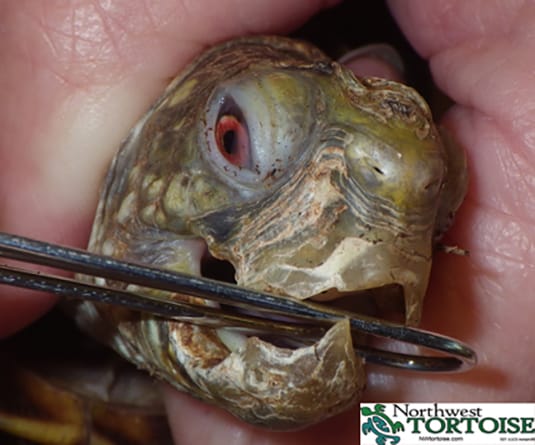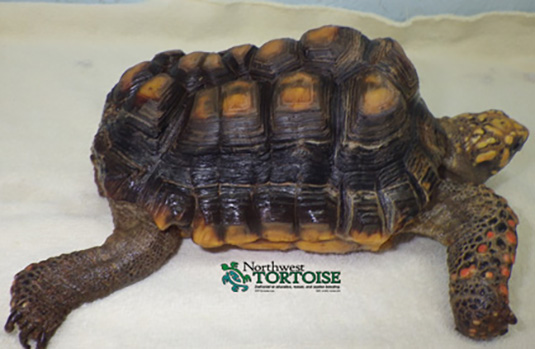About this page
The information on this page DOES NOT replace advice and/or treatment from a qualified exotics veterinarian.
The information on this page is meant for owners and hobbyists seeking to understand the common health problems in turtles and tortoises. The majority of ailments can be attributed to poor or incorrect care. Unfortunately, the pet industry still embraces harmful methods such as glass tanks and non-nutritional processed foods. Many people follow these methods unaware of the result and end up with a sick tortoise.
The descriptions on this page are for new or uninformed turtle/tortoise keepers looking for a basic description of what might be ailing their turtle/tortoise. The information is NOT meant or complete enough to be the last word on the subject.
The descriptions on this page are for new or uninformed turtle/tortoise keepers looking for basic information about tortoise health. This is NOT a complete information source. Please do your own research.
The information on this page DOES NOT replace advice or treatment from a qualified exotics veterinarian.
Abscesses
Abscesses occur on many different parts of a turtle/tortoise. Legs and ears are most common. Abscesses are mostly caused by untreated wounds and/or poor husbandry. Box and aquatic turtles tend to be more susceptible with abscesses. If your turtle/tortoise has an abscess see your veterinarian. An abscess will not go away on its own, and it is painful for the turtle/tortoise.
Once the tortoise has been treated, assess the husbandry, and try to find the cause to prevent further abscesses.
Beak health
An overgrown beak occurs when the turtle/tortoise does not have the set-up for natural wear and health of their beak.
Overgrown beaks are caused by not letting the turtle/tortoise be a turtle/tortoise. In the wild, their food is not cut up or trimmed for them. Turtles and tortoises rip and shred their food using their front legs to assist in controlling the food. This action naturally files down the beak. In captivity, turtles/tortoises should be given a cuttle bone and allowed to rip and shred their food to keep their beak trimmed.
If your turtle/tortoise has an overgrown upper or lower beak, it will need to be trimmed before preventative methods will be effective. /Find a qualified exotics vet for a trim.
Constipation/blockages
If a turtle/tortoise does not poop for a long time or a normal time for the individual, it could be constipated or have a blockage. Unfortunately, in captive conditions, constipation and blockages are common when husbandry is incorrect or flawed. Dehydration is a common cause. Chipped bedding the pet industry sells can also cause blockages.
Soaking a turtle/tortoise in warm water can help expel waste. Feeding pumpkin can also be used to help expel waste; it is a natural laxative. Coating food with mineral oil lubricates the insides and helps expel waste.
If the turtle/tortoise is not eating, is lethargic, or is straining without getting anything out, a visit to a qualified exotics vet is in order.
General swelling
The anatomy of a turtle/tortoise does not allow swelling to present anywhere except the neck and/or limbs. The cause of swelling or puffiness is difficult to diagnose. Causes can include trouble digesting food, an insect bite, parasitic infection, toxin buildup, constipation or a host of other, potentially life-threatening ailments.
Soaking the turtle/tortoise in warm water might help process or expel the cause of the swelling. A review of husbandry to help determine the cause is in order. If the swelling continues, seek a qualified exotics vet.
Hatchling failure syndrome
Hatching failure syndrome is used as a catch-all to explain why a hatchling turtle/tortoise fails to thrive. Despite perfect care, some hatchlings do not survive. Most of hatchlings that do not survive are receiving incorrect care. The perpetuated myth that hatchlings can tolerate the same care as adults, is just that, a myth. Hatchlings need exceptional care to thrive.
An example of incorrect hatchling care is when they are sold in deli cups at reptile shows. These hatchlings are MAYBE 30 days old. They are put in a car or airplane (incorrect temperature), transported many miles (stress), and end up on a table in a busy convention center (more stress). They sit there until they are sold. Sometimes they are sold quickly and sometimes they spend the night in the convention hall (still not at a correct temperature and still stressed) and go through the entire exercise again.
Hatchlings are not strong enough to withstand this level of stress. On a personal note, I have counseled more buyers than I can count who unknowingly bought from this situation and the turtle/tortoise died shortly after. If you want a hatching: Seek out information on correct hatchling care.
Metabolic Bone Disease (MBD)
MBD is probably the most difficult subject to simplify or explain in a short-written piece. A very unscientific and basic definition is that: MBD encompasses poor care. Turtles/tortoises need proper nutrition to build strong bones, muscles, and ligaments. If they don’t get proper nutrition, MBD will present as a pyramided, sunk-in, or soft-spongy shell; legs that shuffle because they don’t have the strength to support the turtle/tortoises weight; an elongated body; distorted jaw deformities; and a host of internal issues.
The best line of defense against MBD is proper nutrition and correct overall care for your turtle/tortoise. Research reputable websites, books, articles etc. and learn about the species you have. The more you understand correct care, the less chance of MBD becoming an issue.
For a comprehensive article by a well-respected author on this subject, see the Resources page of this website.
Nail health
Healthy nails are an important part of turtle/tortoise husbandry. Nails can be easily infected with fungus and bacteria if the enclosure is not kept clean. If your tortoise has overgrown nails – cut them like you would a dog or cat’s nails. The nail has a cuticle that will bleed if cut too short.
“Poop-stash”
Does your tortoise eat so much poop it has a black moustache? If so, something is wrong. Most animals eat some of their own poop or other animal’s poop, but it is not a normal part of their diet.
I cannot say for certain why a tortoise chooses to eat poop. Maybe they are hungry or are missing some nutrient they are trying to replace.
If your tortoise is eating poop, it is time to reassess their diet and husbandry regimen.
Prolapse
A prolapse is the act of internal organs or tissues abnormally exiting the body. A tortoise may prolapse for a number of reasons. The most common is constipation or a blockage from improper nutrition. If your turtle/tortoise has a prolapse, prioritize moisture with a water-based lubricant. Do not let it dry out. Get the tortoise to a qualified exotics veterinarian as soon as possible. Prolapses are life-threatening.
Once the tortoise has been treated, assess the husbandry, and try to find the cause to prevent further occurrences.
Respiratory infections
Respiratory infections are probably the most common turtle/tortoise ailment. Turtles/tortoises have an ‘S’-shaped trachea, This makes it difficult for them to breathe, especially when the head is in the shell. They cannot cough or expel mucus. Uncleared mucus can cause a respiratory infection to turn into pneumonia.
Many respiratory infections are caused by poor care. A weakened immune system, malnutrition, incorrect temperatures, stress, dehydration, and overcrowding will make it easy for an infection to start.
Some symptoms can be easy to diagnose while others are not. Turtles/tortoises do not show any obvious signs of sickness unless it is very advanced. Early stages include wheezing, rubbing its eyes, and discharge from the nostrils, eyes, or mouth. By the time most people see swollen eyes, a respiratory infection has progressed to pneumonia.
If the turtle/tortoise has pneumonia, signs may include open-mouth breathing, and exaggerated pumping of the head and legs (trying to breathe and weakness in the lungs). Pneumonia can progress quickly and cause death in just a few hours.
If your turtle/tortoise has any of the above symptoms, take the tortoise/turtle to a qualified exotics vet ASAP. Respiratory infections DO NOT GO AWAY WITHOUT MEDICATION.
Septicemia
When a turtle/tortoise’s immune system is overwhelmed by an infection that invades the bloodstream, it is septic. Septicemia often results from an undiagnosed chronic disease. It can originate in any part of the body and is hard to spot for inexperienced keepers or rescuers. Red blotching, lethargy, red flush on the bottom of the shell, hemorrhages, loss of appetite and sloughing of scales may all be sign of septicemia.
Septicemia is a life-threatening ailment. If you think your tortoise is suffering from it, get the tortoise to the vet ASAP.
Shell rot
Shell rot is another typical ailment seen in rescue. It presents as pitting or sores on the shell. When an abrasion or cut allows bacteria or fungus below the keratin an infection can take place. Once the infection has begun, a qualified exotics vet is needed.
Dry shell rot:
Land-bound tortoises and box turtles develop a rot from a fungus. If the infection is not treated it, can spread to other parts of the body and result in septicemia.
Wet shell rot:
Wet shell rot presents with a poor smelling oder, softening of the scutes, discharge and areas of pitting, and scutes falling off. It often results from bacteria that enters a cut or lesion.
If you think your turtle/tortoise has shell rot, seek advice from a qualified source. There are home remedies that can be effective, but if the case is severe, a trip to a qualified exotics vet is required.
Additionally, review husbandry to determine the cause.
“Swamp-butt”
Swamp-butt refers to the tortoise’s rear-end that is wet, smelly, and generally disgusting. A tortoises rear-end should be clean and without an overly offensive smell. Swamp-butt indicates something is wrong in the digestive or absorption processes as food travels through the system. Is the tortoise being fed incorrectly? Is it trying to process something it cannot, such as a Sulcata trying to digest animal protein? Is the tortoise being fed too much or not enough? Is the tortoise being fed wet leafy greens when it should have dry grasses?
If your tortoise has swamp-butt, review the diet first and then husbandry.
Swollen eyes
Swollen eyes are a symptom of poor health. By the time a tortoise shows symptoms, the situation is serious. Swollen eyes do not represent a specific sickness or diagnosis. In dated material, it is attributed to a Vitamin A deficiency. We now know that is not the end of the story.
If your turtle/tortoise has swollen eyes, review husbandry. If you do not know what kind of tortoise you have or the care requirements, seek information.



















































